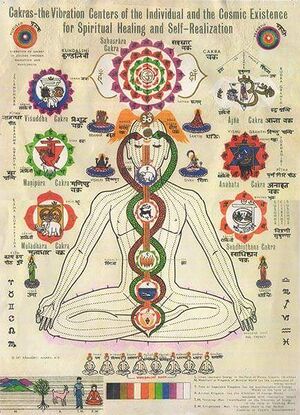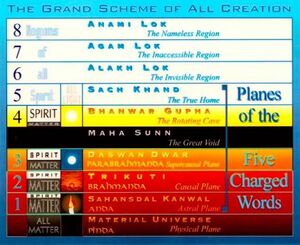Surat Shabd Yoga


Surat Shabd Yoga also known as SEHAJ YOG or SANT MAT is a type of spiritual yoga practice in the Sant Mat tradition. This yoga has its roots in Vedantas and Upanishads, even Shri Krishna told Arjun in the Mahabharat war, how to practice it. Lots of spiritual branches of religions like Sufism in Islam and Sikhism has also adopted its doctrines.
Famous people through ages practicing and preaching this yog
- Vashist Muni
- Vishwamitra - took him ages to understand, but finally he became "Brahmrishi"
- Machandar Nath
- Kabir,
- Gorakhnath,
- Paltu,
- Tukaram,
- Meera Bai,
- Rai Das
Famous Jat researchers in Surat shabd
This yoga has attracted many Jats like
- Dhanna Bhagat,
- Sardar Bahadur Jagat Singh Kaler,
- Sant Tarachand,
- Baba Sawan Singh ji,
- Master Kunwar Samota.
Key Elements
There are basic key elements that makes a practitioner strong by following those, such as
- Sumiran or Jaap - recital of name (This make the concentration strong),
- Satvikta - only eating Pure vegetarian (no meat or egg or any type of killing of animal for food),
- Brahmacharya or Celebacy - controlling lust
- Truth - telling always truth no matter how hard it is.
- Sewa or Free Service - Helping others and expecting nothing in return,
- No anger - being very simple and generous,
- Greed - enough for yourself to survive ,if rich then helping poor,
- Attachment - This human life is to stay away from attachment of any kind (kids, house, money) example the story of Raja Jad Bharat [1]
- Ego or Ahankar - not to have ego or pride about everything ( lots of people begs and do sewa of shoes at temple or pick utensils in Bhandar just to kill ego) Krishna also picked utensils when he went to the Rajasuya yagya of Yudhistir in Indraprast.
Etymology
Surat is "attention" or "face", that is, an outward expression of the soul; Shabd or Shabda has multiple meanings including ‘sacred song’, ‘word’, ‘voice’, ‘hymn’, ‘verse’, or ‘sound current, ‘audible life stream’, and the ‘essence of the Absolute Supreme Being’. The Absolute Supreme Being is a dynamic force of creative energy sent out into the abyss of space at the dawn of the universe's manifestation, as sound vibrations. These vibrations continue and are sent forth through the ages, framing all things that constitute and inhabit the universe.[2] Yoga is literally ‘union’, or ‘to yoke’. Etymologically, Surat Shabd Yoga means the ‘Union of the Soul with the Essence of the Absolute Supreme Being’.
Surat Shabda Yoga is also known as Sehaj Yoga – the path leading to Sehaj or equipoise, The Path of Light and Sound, The Path of the Sants or 'Saints', The Journey of Soul, and The Yoga of the Sound Current.
Basic principles
Surat Shabda Yoga is for the discovery of True Self (Self-Realization), True Essence (Spirit-Realization), and True Divinity (God-Realization) while living in the human physical body. This involves reuniting in stages with what is called the "Essence of the Absolute Supreme Being", also known as the "Shabd or Word". Attaining this extent of self-realization is believed to result in jivan moksha/mukti, which is liberation/release from samsara and positivity in the cycle of karma and reincarnation. Initiation by a contemporary living Satguru (Sat - true, Guru - teacher) is considered a prerequisite for successful sadhana (spiritual exercises). The sadhanas include simran (repetition, particularly silent repetition of a mantra given at initiation), dhyan (concentration, viewing, or contemplation, particularly on the Inner Master), and bhajan (listening to the inner sounds of the Shabd). The mantra is Guru Manter. These are some verbal words that one gets from living masters and chants in mind, not with the mouth. As the language varies from culture to culture, Guru Manter or Mantra may also vary from culture to culture in spirituality. On the other hand, Naam or Word of God or Kalma is unspeakable, alive and no one can write it on paper. In the new testament "Hebrews 4:12" states, "For the Word of God is living and active. Sharper than any double-edged sword, it pierces even to dividing soul and spirit, joints and marrow. It judges the thoughts and intentions of the heart." Words which we write on paper are not alive and active. According to Scripture, the Word of God has existed since the beginning of the world, prior to any man-made language.
Surat Shabd Yoga arose in India in the last several hundred years, specifically in the Sikh tradition (Nanakpanthi) founded by Guru Nanak. The practice of meditation (Shabad), which is the central core practice of Surat Shabd Yoga, is derived from the ancient Hindu practice of nāda yoga. Nada yoga is expounded in various Hindu scriptures such as the Nadabindu Upanishad, an ancient text affiliated with the several thousands-year-old Rig Veda. The practice of nāda yoga within Hinduism has been widely affiliated within many yoga traditions including bhakti or devotional yoga, kundalini and tantric yogas, laya yoga, and raja yoga. Modern Hindu teachers still emphasizing nada yoga include Swami Sivananda, Swami Rama, Rammurti Mishra (Shri Brahmananda Sarasvati), Paramahansa Yogananda (Kriya Yoga Lineage), and many others. The practice of nāda yoga is an integral part of various other traditions as well, such as being a form of the advanced thogal practice in the Tibetan Dzogchen lineage, and is mentioned by H. P. Blavatsky, founder of the Theosophical Society in her book "The Voice of the Silence". The form of Surat Shabd Yoga, practiced by followers of Sant Mat and the Sikh tradition (nanakpanthi), is most commonly related to nāda yoga. Furthermore, nāda yoga resembles and combines elements from the Hindu practices of raja yoga, laya yoga, and bhakti yoga.
Movements and masters
Main articles: Sant Mat, Contemporary Sant Mat movement, and Radha Soami Adherents believe Surat Shabda Yoga has been expressed through the movements of many different masters. However, a basic principle of Surat Shabd Yoga's tradition is the requirement for an outer Living Master to initiate followers onto the Path. The movements whose historical Satgurus have died and their successors do not purport themselves to be Surat Shabd Yoga Satgurus, usually are not considered currently to be Surat Shabd Yoga movements, either by their own leaders or by movements with current Living Masters.
Satguru Maharshi Mehi Paramahansa Ji Maharaj is considered the movement leader in the 20th century. He came to an isolated cave of Kuppaghat, Bhagalpur (Bihar, India) and practiced Surat-Shabda Yoga from March 1933 - November 1934. He achieved self-realization and attained ultimate salvation during his practice. He wrote books "Moksha-Darshan (Philosophy of Salvation), "Satsang-Yoga", "Shri Gita-Yoga Prakash", "Raamcharit Maanas Saar-Satik", "Maharshi-Mehi-Padaawali" and "Maharshi-Mehi-Padawaali".
The Radhasoami movement of Surat Shabda Yoga was established by Shiv Dayal Singh (1818–1878) in 1861 and named "Radhasoami Satsang" circa 1866. Soamiji Maharaj, as he was known, presided over the satsang meetings for seventeen years at Panni Gali and Soami Bagh in Agra, India, until he died on June 15, 1878.[3] Accounts of his guru and successors vary, although he gave verbal instructions on his last day as to how his followers should be cared for.[4] According to Radha Soami Satsang Beas, his guru was Tulsi Sahib of Hathras. According to the successors Soami Bagh and Dayal Bagh, Tulsi Sahib [5] was a contemporary guru of the same teachings; but being a natural born Satguru, Shiv Dayal Singh himself had no guru.
After his death, six immediate successors carried on Shiv Dayal Singh’s teachings, including Huzur Maharaj Rai Salig Ram of Peepal Mandi, Agra, and Babaji Maharaj Jaimal Singh of Dera Baba Jaimal Singh the present day headquarters of (RSSB), Radha Soami Satsang Beas. More information on living masters related to Shiv Dayal Singh's lineage can be found in the Contemporary Sant Mat movement article.
Sant Kirpal Singh, a contemporary Sant Mat guru, stated that "Naam" ("Word") has been described in many traditions through the use of several different terms. In his teachings,[6] the following expressions are interpreted as being identical to "Naam":
"Naad", "Akash Bani", and "Sruti" in the Vedas "Nada" and "Udgit" in the Upanishads "Logos" and "Word" in the New Testament "Tao" by Lao Zi "Music of the Spheres" by Pythagoras "Sraosha" by Zoraster "Kalma" and "Kalam-i-Qadim" in the Qur'an "Naam", "Akhand Kirtan", and "Sacha ('True') Shabd" by Guru Granth Sahib
Gallery
External Links
- International Yoga Day
- https://youtu.be/zZIip8x6-BM
- https://youtu.be/uSF5wPY4x8s
- https://www.youtube.com/watch?v=xG884WmIYVg
- https://medium.com/@sant_mat/requirements-for-initiation-in-sant-mat-surat-shabd-yoga-the-inner-light-and-sound-of-god-inner-fbda9ac4f03e
- https://psychology.wikia.org/wiki/Surat_Shabd_Yoga
- https://www.ruhanisatsangusa.org/col/col-5a.htm
- http://www.integralworld.net/lane101.html
References
Back to The Reformers Jat Organizations



